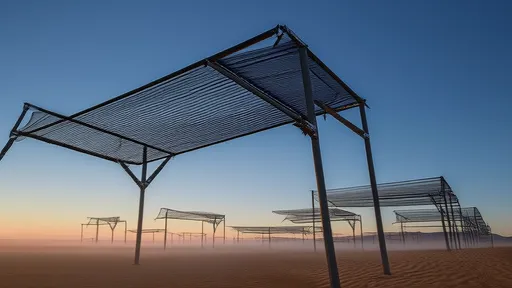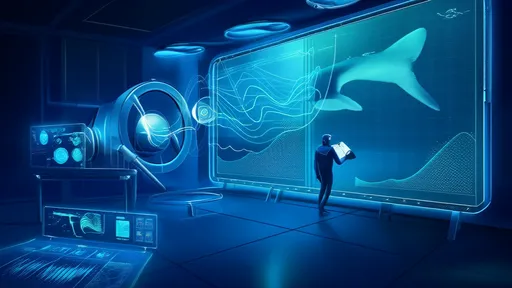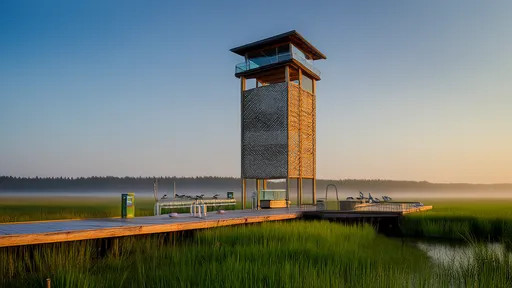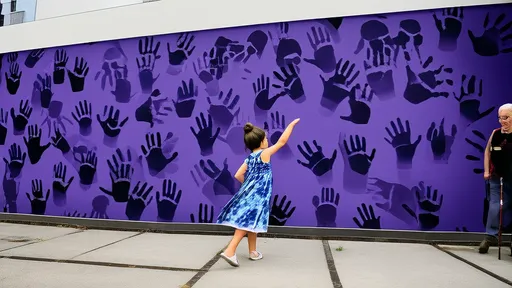The walls of the museum pulse with invisible life. As visitors pass through the galleries, their body heat leaves ghostly traces on surfaces coated with thermochromic paint—a modern alchemy where human presence becomes fleeting art. This is "Thermal Frescoes: Visitor Traces in Heat-Sensitive Pigments," an exhibition blurring the lines between spectator and spectacle, between the ephemeral and the eternal.
Walking into the dimly lit space feels like entering a living organism. The walls, initially appearing as monochromatic planes, gradually reveal their secret language. Where a child pressed their palm, a violet handprint glows like a bruise. A couple lingering near a corner leaves overlapping silhouettes in searing orange—their intimacy frozen in temperature gradients. The pigments respond not just to presence, but to duration and intensity; a security guard’s habitual patrol route materializes as a fading yellow comet tail.
Curator Dr. Elisa Varga describes the project as "archaeology of the immediate." Unlike traditional frescoes that demand years of meticulous labor, these thermal murals document moments that evaporate within hours. "We’re accustomed to art that outlives its creators," she says, running fingers through a cobalt streak left by her own shoulder. "Here, the artwork dies countless little deaths, only to be reborn with each new visitor." The gallery’s climate control system ensures the canvas never fully resets; residual warmth from morning crowds lingers as faint bruises beneath the afternoon’s vibrant new marks.
The technology behind the exhibition draws from military infrared camouflage research. Microscopic polymer capsules in the paint undergo structural changes at specific temperatures, scattering light differently when heated. But where defense applications seek invisibility, this installation craves legibility—every degree of warmth translated into jewel-toned visibility. A technician demonstrates by breathing onto a test panel: his exhale blossoms into emerald tendrils that writhe before dissolving.
Visitor reactions become part of the choreography. Some move cautiously, afraid to "smudge" the developing composition. Others deliberately press cheeks or torsos against walls, treating the space as both guestbook and confessional. One teenager lies supine for twenty minutes, later standing back to admire his full-body imprint in pulsating crimson—a martyr’s shadow without the martyrdom. The most poignant traces often come from stillness: a wheelchair user’s prolonged presence manifests as a deep indigo pool with radiant spokes.
Critics debate whether this constitutes art or augmented surveillance. The museum’s heat maps could theoretically identify individuals based on their thermal signatures—an unintended consequence that raises eyebrows among privacy advocates. Dr. Varga counters that all galleries monitor movements, just less poetically: "Security cameras record your silhouette; we record your warmth. The difference is we let you see the data as something beautiful."
As closing time approaches, the walls reach peak saturation—a cacophony of overlapping biomorphic shapes resembling a tropical reef at noon. By tomorrow’s opening, these vibrant organisms will have faded to faint whispers, making room for new stories written in body heat. In an era where digital footprints feel oppressive, there’s liberation in leaving marks that refuse to fossilize. The thermal frescoes remind us: some traces should be temporary, some memories meant to melt.

By /Jul 16, 2025

By /Jul 16, 2025

By /Jul 16, 2025

By /Jul 16, 2025

By /Jul 16, 2025

By /Jul 16, 2025

By /Jul 16, 2025

By /Jul 16, 2025

By /Jul 16, 2025

By /Jul 16, 2025

By /Jul 16, 2025

By /Jul 16, 2025

By /Jul 16, 2025

By /Jul 16, 2025

By /Jul 16, 2025

By /Jul 16, 2025

By /Jul 16, 2025

By /Jul 16, 2025